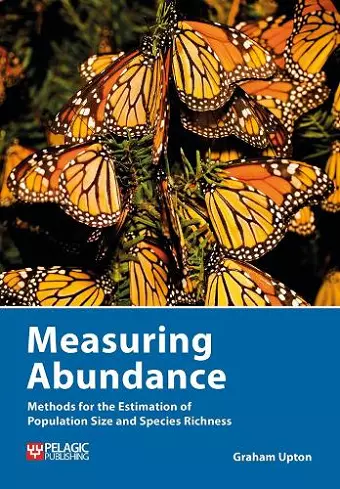Measuring Abundance
Methods for the Estimation of Population Size and Species Richness
Format:Paperback
Publisher:Pelagic Publishing
Published:12th Oct '20
Should be back in stock very soon
This paperback is available in another edition too:
- Hardback£75.00(9781784272326)

Measuring the abundance of individuals and the diversity of species are core components of most ecological research projects and conservation monitoring. This book brings together in one place, for the first time, the methods used to estimate the abundance of individuals in nature.
The statistical basis of each method is detailed along with practical considerations for survey design and data collection. Methods are illustrated using data ranging from Alaskan shrubs to Yellowstone grizzly bears, not forgetting Costa Rican ants and Prince Edward Island lobsters. Where necessary, example code for use with the open source software R is supplied. When appropriate, reference is made to other widely used programs.
After opening with a brief synopsis of relevant statistical methods, the first section deals with the abundance of stationary items such as trees, shrubs, coral, etc. Following a discussion of the use of quadrats and transects in the contexts of forestry sampling and the assessment of plant cover, there are chapters addressing line-intercept sampling, the use of nearest-neighbour distances, and variable sized plots.
The second section deals with individuals that move, such as birds, mammals, reptiles, fish, etc. Approaches discussed include double-observer sampling, removal sampling, capture-recapture methods and distance sampling.
The final section deals with the measurement of species richness; species diversity; species-abundance distributions; and other aspects of diversity such as evenness, similarity, turnover and rarity.
This is an essential reference for anyone involved in advanced undergraduate or postgraduate ecological research and teaching, or those planning and carrying out data analysis as part of conservation survey and monitoring programmes.
A real strength of Measuring Abundance is the simplicity of the writing. One highlight that helps to transform the book into something more than a true reference manual is the advice and sampling tips scattered throughout
-- Jo A. Werba * Quarterly Review of Biology *An excellent resource for ecologists, ornithologists, wildlife researchers and environmentalists...and an excellent addition to any library’s collection.
-- Kuldeep Kumar * Journal of the Royal Statistical Society: Statistics in Society *Measuring Abundance is an excellent tool for agency and non‐governmental biologists looking to better understand baseline population sizes or develop long‐term monitoring programs. Furthermore, for many graduate students, this book may be a useful resource for reviewing and covering a range of methods available to measure abundance.
-- Molly McDevitt, The Journal of Wildlife ManageISBN: 9781784272319
Dimensions: unknown
Weight: 430g
229 pages